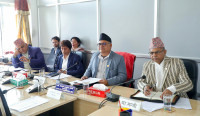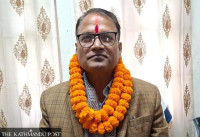National
A year held hostage by the Nepal Communist Party feud
The infighting in the ruling party reached a tipping point as 2020 drew to a close. Oli dissolved the House and called snap polls resulting in the party split and forcing the country towards uncertainty.
Anil Giri
The year 2020 started with the KP Sharma Oli administration marking its second year in power. But throughout the year, it courted controversy.
Poor governance amid the pandemic became the hallmark of the Oli government. Corruption allegations disgraced his government on numerous occasions while relations with India dipped to an all time low over border issues.
On the party’s front, the bitter infighting between Oli and his rival Pushpa Kamal Dahal reached its crescendo when the former dissolved the House of Representatives, which led to the party split.
Meanwhile, the Nepali Congress, which was the main opposition until December 20, continued to be a divided house, fighting factional feuds. The Janata Samajbadi Party, which came into being in April after the merger between Rastriya Janata Party and Samajbadi Party Nepal, remained a disoriented force, struggling to “manage'' its leaders' egos.
All in all, 2020 was a chaotic year with people barely getting a sense of stability, analysts say.
“This has been one of the most disastrous years for Nepal,” said Lok Raj Baral. “And the pandemic was unforgiving.”
In the third week of January, the country first reported its Covid-19 case. Whether the virus would take hold of the country was not a matter of if but when. However, the governing Nepal Commiunist Party had brought its factional fight from the previous year into 2020 as well, which gave the Oli administration to pay attention to the looming threat. The little efforts it made in the name of fighting the pandemic were mired in controversy, with some ministers facing corruption allegations.
In March, the country went into lockdown, which lasted for four months. The internal drama in the Nepal Communist Party, however, continued.
The Pushpa Kamal Dahal led faction was upping the ante against Oli’s “unilateral style” of running the party and the government.
Just as infighting in the Nepal Communist Party grew, the Chinese interest too increased. In May when the spectre of a party split raised its head, Chinese Ambassador Hou Yanqi met with various leaders. A truce returned to the party. But in July again, the Dahal faction, backed by senior CPN-UML leaders Madhav Kumar Nepal, Jhala Nath Khanal and Bamdev Gautam, stepped up efforts to force Oli to step down. Ambassador Hou once again got active.
The party then formed a six-member task force to suggest ways to save the party unity and provided some prescriptions. Accordingly, on September 11, the Standing Committee made a slew of decisions, including Oli will take all the decisions in consultation with the party leadership and Dahal will assume the post of “executive chair” to look after party affairs.
Oli refused to abide by party decisions. The Dahal faction then made strategies to corner Oli, who had already accused the Dahal faction and even India of trying to unseat him.
The real fight was in full display in November.
At the November 13 Secretariat meeting, Dahal presented his 19-page political document, levelling serious charges against Oli–failing to lead the government, promoting corruption and refusing to comply with party decisions. Dahal even said that it was time Oli “made a sacrifice” for the sake of the party, the constitution, and the country.
On November 28, Oli presented a rebuttal to Dahal, in the form of a 28-page document, not only countering allegations point-wise but also issuing veiled threats.
Analysts say the situation in the Nepal Communist Party had gone from bad to worse and that it had already become apparent that the unity declared in May 2018 was fragile. The glue that had kept Dahal and Oli together had already dried.
“Apart from the coronavirus, the country in 2019 was hit by a political pandemic. The never-ending debate, blame-game, conflict dominated Nepal’s politics throughout the year,” said Geja Sharma Wagle, a commentator who regularly writes on contemporary politics and security matters for the Post’s sister paper Kantipur.
Oli, who since the day of assuming office had been attacking the system one step at a time, then made a surprise move on December 15. He reintroduced an ordinance related to the Constitutional Council Act. President Bidya Devi Bhandari endorsed it, drawing widespread censure for swiftly approving an ordinance which was repealed earlier in April after massive criticism.
The ordinance drove a wedge between Oli and Dahal. The Standing Committee meeting of the party on December 16 demanded that Oli withdraw the ordinance. He agreed to withdraw it but refused to do so.
The Dahal-Nepal faction then put a squeeze on Oli, who in turn, on December 20, recommended that the President dissolve the House of Representatives. As usual, the Office of the President complied. There was public outrage against the Office of the President.
On the morning of December 22, Oli held a meeting of the Central Committee at Baluwatar with leaders close to him. The Dahal-Nepal faction organised their own meeting of the Central Committee at Babarmahal the same day in the afternoon.
The separate meetings of the two factions marked the end of the unity that was announced in May 2018.
The party split in two. Which Nepal Communist Party–led by Oli or the Dahal-Nepal faction–is the legitimate one is for the Election Commission to decide.

The Dahal-Nepal faction, however, took to the streets. As many as 13 writs are being heard by the Supreme Court to test if Oli’s move of dissolving the House has constitutional validity, as experts say the constitution does not allow a majority prime minister to dissolve the House.
Analysts say Oli had always been displaying his authoritarian impulses but it was far from anyone’s anticipation that he would dissolve the House.
“The way the dispute in the ruling party led to House dissolution was just a massive blow to democracy,” said Baral. “Oli totally failed on all fronts. He could neither deliver nor protect the constitution.”
Analysts pointed at some events in the lead up to the House dissolution.
New Delhi, which had ignored Nepal’s calls for dialogue after ties soured following India’s move of placing Kalapani within its borders in a new map published in November 2019, in October suddenly sent the chief of its foreign spy agency to Kathmandu.
Samant Kumar Goel, the chief of India’ Research & Analysis Wing, held a “secret” meeting with Oli on the night of October 21 at Baluwatar. Though the information about the meeting was in public domain, what transpired between them was never made public.
Earlier in May, India’s inauguration of a road link via Lipulekh to Kailash Mansarovar in the Tibet Autonomous Region of China had led to further souring of Nepal-India ties.
The Oli government ratcheted up its nationalist rhetoric. It then got a new Nepali map depicting Kalapani, Lipulekh and Limpiyadhura within Nepali borders endorsed by Parliament.
Nepal-India relations hit a new low.
Oli even went on to say that the “real” Ayodhya, the birthplace of Lord Ram, lies in Nepal and ordered to build a Ram Temple in Madi of Chitwan.
It looked like Oli was bent on destroying ties with India, say analysts.
“The only remarkable event in 2020 is the publication of a new map of the country,” said Wagle. “But the government and the governing party could not handle it properly, resulting in diplomatic debacle with India. It undermined the sensitivity of Nepal-India relations in the given context.”
But immediately after Goel’s visit, a month later, India sent the chief of its army to Nepal. Then came the visit of Indian Foreign Secretary Harsh Vardhan Shringla, who immediately after his arrival launched a charm offensive, speaking in Nepali. Shringla held a series of meetings in Kathmandu and reassured Delhi’s support in Nepal’s quest for stability and prosperity.
Back-to-back visits from India brought a semblance of peace between Kathmandu and Delhi.
The Chinese concerns had started to grow then only, say analysts.
Two days after Shringla’s visit, Beijing sent Defence Minister Wei Fenghe to Kathmandu on a day-long trip. He held talks with the President, Nepal Army chief, Prime Minister Oli.
Chinese interest to keep the Nepal Communist Party unity intact was always apparent. But the party ultimately split.
Five days after the party split, Beijing rushed a four-member delegation led by Guo Yezhou, a vice-minister in the Communist Party of China, to Kathmandu to “assess” the situation in Kathmandu.
After dissolving the House, Oli called snap polls for April 30 and May 10.
Caught unawares by Oli’s move, the Chinese tried to find a formula that could save the Nepal Communist Party unity.
But things had gone too far.
As the country enters into 2021, there are uncertainties ahead. To make matters worse, the pandemic has shown no signs of abating.
Observers say the Oli-Dahal feud held the country and the government hostage throughout 2020.
“Some notorious decisions by the Oli government seriously jeopardized the evolving, fluid, and fragile national politics, putting democracy and constitution at high risk,” said Wagle. “As the battle of egos between Oli and Dahal reached the tipping point, the Oli government wrapped up the year with a surprise move of dissolving the House and declaring snap polls. As the country heads into 2021, it is staring at uncertainties galore.”




 8.12°C Kathmandu
8.12°C Kathmandu















